Click on “+” to reveal description.

Wind/storm, tornado, hurricane
 Tornados, hurricanes and severe windstorms often leave a path of damage ranging in magnitude from total devastation to minor damage. It is only natural for a building owner to take a close look at their structure following a storm and find damages which they did not recall being present before the storm. By understanding how wind affects buildings, knowing the difference between new damage and older damage, and by using wall lean and floor level surveys, we can quickly determine what damages, if any, are related to wind storms. Our engineers assess structural damage as well as make determinations on wind versus rising water and storm surge. We can also evaluate damage to seals of thermal windows and determine whether it is related to storm effects or to natural aging. We are catastrophe-tested and ready to provide the crucial and timely analyses that are vital in the assessment of damage.
Tornados, hurricanes and severe windstorms often leave a path of damage ranging in magnitude from total devastation to minor damage. It is only natural for a building owner to take a close look at their structure following a storm and find damages which they did not recall being present before the storm. By understanding how wind affects buildings, knowing the difference between new damage and older damage, and by using wall lean and floor level surveys, we can quickly determine what damages, if any, are related to wind storms. Our engineers assess structural damage as well as make determinations on wind versus rising water and storm surge. We can also evaluate damage to seals of thermal windows and determine whether it is related to storm effects or to natural aging. We are catastrophe-tested and ready to provide the crucial and timely analyses that are vital in the assessment of damage.
Earthquake
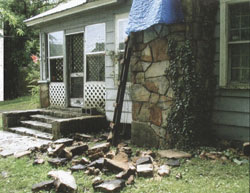 Even in the southeast united states, earthquakes occur relatively frequently, but they usually are of a low magnitude and non-damaging. However the vibrations can still be felt and buildings will respond to it. Occasionally more severe earthquakes occur and damages can be significant because buildings in this area are usually not constructed to resist strong ground movements. We have evaluated dozens of buildings in the southeast after moderate earthquakes occurred and we have been trained in how to evaluate and assess earthquake damages. We are trained and certified in ATC-20, “Post-Earthquake Safety Evaluation of Buildings.”
Even in the southeast united states, earthquakes occur relatively frequently, but they usually are of a low magnitude and non-damaging. However the vibrations can still be felt and buildings will respond to it. Occasionally more severe earthquakes occur and damages can be significant because buildings in this area are usually not constructed to resist strong ground movements. We have evaluated dozens of buildings in the southeast after moderate earthquakes occurred and we have been trained in how to evaluate and assess earthquake damages. We are trained and certified in ATC-20, “Post-Earthquake Safety Evaluation of Buildings.”
Lightning
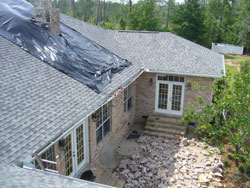 Lightning causes losses in the U.S. of over $5 billion per year. Many of the largest losses are related to building fires caused by a lightning strike. Additional damages can occur to televisions, sound systems, alarm systems, appliances, air conditioners, and house wiring. Because of the high-energy nature of lightning strikes, structural damages are usually dramatic and obvious. However, sometimes, crack patterns can develop that are more difficult to assess. Mysterious malfunctioning of appliances can sometimes be traced to electrical surges related to lightning strikes. By utilizing the national lightning database, and then relying on our forensic experience in evaluating various damages, we can determine whether damage is the result of lightning or of some other cause.
Lightning causes losses in the U.S. of over $5 billion per year. Many of the largest losses are related to building fires caused by a lightning strike. Additional damages can occur to televisions, sound systems, alarm systems, appliances, air conditioners, and house wiring. Because of the high-energy nature of lightning strikes, structural damages are usually dramatic and obvious. However, sometimes, crack patterns can develop that are more difficult to assess. Mysterious malfunctioning of appliances can sometimes be traced to electrical surges related to lightning strikes. By utilizing the national lightning database, and then relying on our forensic experience in evaluating various damages, we can determine whether damage is the result of lightning or of some other cause.
Flooding
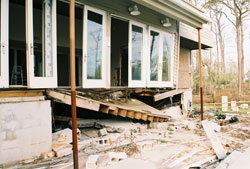 Floods are one of the most common hazards in the United States. Flood effects can be local, impacting a neighborhood or community, or very large, affecting entire river basins and multiple states. However, all floods are not alike. Some floods develop slowly, sometimes over a period of days. But flash floods can develop quickly, sometimes in just a few minutes and without any visible signs of rain. Flash floods often have a dangerous wall of roaring water that carries rocks, mud, and other debris and can sweep away most things in its path. Overland flooding occurs outside a defined river or stream, such as when a levee is breached, but still can be destructive. Flooding can also occur when a dam breaks, producing effects similar to flash floods. Coastal hurricanes almost always result in severe flooding due to storm surge. Because moving water is very forceful, the damages from flooding can be severe, sometimes completely removing a building from its foundation in seconds. Experience and a trained eye are necessary to ascertain damages caused by flooding, especially when other forces are present at the same time, such as wind. Our considerable experience in evaluating hurricane damage and other major floods makes us especially skilled in diagnosing the flooding damages as well as helping in developing a repair protocol.
Floods are one of the most common hazards in the United States. Flood effects can be local, impacting a neighborhood or community, or very large, affecting entire river basins and multiple states. However, all floods are not alike. Some floods develop slowly, sometimes over a period of days. But flash floods can develop quickly, sometimes in just a few minutes and without any visible signs of rain. Flash floods often have a dangerous wall of roaring water that carries rocks, mud, and other debris and can sweep away most things in its path. Overland flooding occurs outside a defined river or stream, such as when a levee is breached, but still can be destructive. Flooding can also occur when a dam breaks, producing effects similar to flash floods. Coastal hurricanes almost always result in severe flooding due to storm surge. Because moving water is very forceful, the damages from flooding can be severe, sometimes completely removing a building from its foundation in seconds. Experience and a trained eye are necessary to ascertain damages caused by flooding, especially when other forces are present at the same time, such as wind. Our considerable experience in evaluating hurricane damage and other major floods makes us especially skilled in diagnosing the flooding damages as well as helping in developing a repair protocol.
Hail and/or wind damage
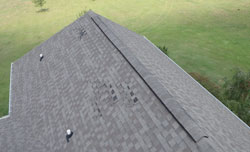 While most roof systems are fairly resistant to damage from hailstone impact, severe hail events involving 1-inch to 2-inch diameter hailstones can lead to extensive damage. Wind damage to roofing is usually obvious, but a detailed inspection is needed to find subtle damages such as creased or cracked shingles. In addition, sometimes roofing products, particularly improperly fastened laminated asphalt shingles, can slide off a roof by gravity when an initial inspection indicates an apparent wind tear-off.
While most roof systems are fairly resistant to damage from hailstone impact, severe hail events involving 1-inch to 2-inch diameter hailstones can lead to extensive damage. Wind damage to roofing is usually obvious, but a detailed inspection is needed to find subtle damages such as creased or cracked shingles. In addition, sometimes roofing products, particularly improperly fastened laminated asphalt shingles, can slide off a roof by gravity when an initial inspection indicates an apparent wind tear-off.
We have been performing hail and wind damage inspections of roofing materials for more than 15 years. We maintain a library of wind and hail damage research and have been trained by authoritative organizations to correctly perform roof inspection. Using our training and extensive experience, we can quickly determine what are legitimate storm damages and what are simply signs of material defects or natural weathering and aging. We are also trained to recognize intentionally caused damages.
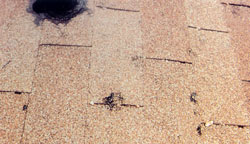 During the inspection process, we walk the roof using ropes and safety harnesses if necessary to assess the general condition. We then section off 100 square foot study areas on each major roof slope and perform close inspections of the roofing inside these areas photo-documenting all deficiencies. We also study the conditions of metallic objects on the roof and around the home to gage the sizes of hail which fell onto the property. With this method we can make sure that the roofing damage is consistent with the size of hail that fell on the property. In addition to our inspections, we perform weather research to further assess the probable sizes of hail stones and to determine the direction any storms traveled.
During the inspection process, we walk the roof using ropes and safety harnesses if necessary to assess the general condition. We then section off 100 square foot study areas on each major roof slope and perform close inspections of the roofing inside these areas photo-documenting all deficiencies. We also study the conditions of metallic objects on the roof and around the home to gage the sizes of hail which fell onto the property. With this method we can make sure that the roofing damage is consistent with the size of hail that fell on the property. In addition to our inspections, we perform weather research to further assess the probable sizes of hail stones and to determine the direction any storms traveled.

Impact (i.e., tree, vehicle and missiles)
 We have evaluated hundreds of homes damaged by felled trees as well as uncontrolled vehicle impacts and other impacts. In our damage assessments, we typically develop scaled drawings of the structure so that we can quickly determine the load paths in various directions throughout the structure. Together with our wall lean and floor level surveys, as well as a close examination of the crack and damage patterns, we can determine what damages are associated with the impact and what aren’t. We can also develop structural repair plans to aid in the adjusting process and assist the repair contractor in his work.
We have evaluated hundreds of homes damaged by felled trees as well as uncontrolled vehicle impacts and other impacts. In our damage assessments, we typically develop scaled drawings of the structure so that we can quickly determine the load paths in various directions throughout the structure. Together with our wall lean and floor level surveys, as well as a close examination of the crack and damage patterns, we can determine what damages are associated with the impact and what aren’t. We can also develop structural repair plans to aid in the adjusting process and assist the repair contractor in his work.
Blasting damage evaluation
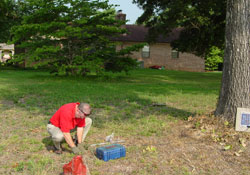 Blasting is the technique used to break rock sufficiently so it can be excavated and removed. To accomplish this, drills are used to create a pattern of boreholes distributed evenly throughout the rock to be shattered. When explosives are detonated, they release huge amounts of energy in the form of heat, sound, and shockwaves (ground vibrations). The shockwaves and the force exerted on the rock produce vibrations in the rock and earth surrounding the blast site. The vibrations created can be compared to waves created when a rock is dropped into a lake: the waves spread out in all directions and gradually decrease as the distance from the source increases. Eventually, the vibrations completely die out – a decay phenomena known as attenuation.
Blasting is the technique used to break rock sufficiently so it can be excavated and removed. To accomplish this, drills are used to create a pattern of boreholes distributed evenly throughout the rock to be shattered. When explosives are detonated, they release huge amounts of energy in the form of heat, sound, and shockwaves (ground vibrations). The shockwaves and the force exerted on the rock produce vibrations in the rock and earth surrounding the blast site. The vibrations created can be compared to waves created when a rock is dropped into a lake: the waves spread out in all directions and gradually decrease as the distance from the source increases. Eventually, the vibrations completely die out – a decay phenomena known as attenuation.
Mine and construction blasting has been a heavily studied industry in regards to its adverse effects on people, buildings, and the overall environment surrounding the immediate area of the blasting site. Given this research, regulatory agencies have been able to generally agree upon and adopt several conventional criteria for restricting, regulating, and predicting the effects of mine and construction blasting. Generally, if the explosive levels are maintained within recommended limits, there can be no structural damage to nearby buildings, even though the buildings will respond by shaking. Since people inside the buildings are much more sensitive to the vibrations that the buildings themselves are, nearby blasting often leads to damage claims.
We have been performing blasting damage inspections for more than 15 years and we are very familiar with the latest technologies and research. In our damage assessments, we photo-document the damages, determine the distance between the building and construction/mine site where the blasting was conducted, research the explosive activities, review shot reports and seismograph records if possible, and perform Scale Distance and Regression calculations if needed. With this information, a conclusive determination can be made regarding the cause of the damages.
Foundation cracking
 We have investigated thousands of foundation failures in residential, commercial, and industrial structures. Typically settlement is the primary parameter when dealing with foundation failure, but the underlying cause of the settlement can also be important. For example, we have found issues with original design and construction errors, storm and flood damages, land slides, vehicle impact damages, mine subsidence, earthquakes, plumbing leaks, and blasting vibrations. Only a careful and detailed inspection and analysis, often utilizing floor level surveys, can determine the true cause of foundation damage. We also have extensive experience in developing repair plans for foundation damages, utilizing carbon-fiber straps, carbon fiber staples, epoxy injection, steel helical piles and steel driven piles.
We have investigated thousands of foundation failures in residential, commercial, and industrial structures. Typically settlement is the primary parameter when dealing with foundation failure, but the underlying cause of the settlement can also be important. For example, we have found issues with original design and construction errors, storm and flood damages, land slides, vehicle impact damages, mine subsidence, earthquakes, plumbing leaks, and blasting vibrations. Only a careful and detailed inspection and analysis, often utilizing floor level surveys, can determine the true cause of foundation damage. We also have extensive experience in developing repair plans for foundation damages, utilizing carbon-fiber straps, carbon fiber staples, epoxy injection, steel helical piles and steel driven piles.
Chimney movement
 We have inspected hundreds of leaning chimneys over the years and have discovered that many problems are due to insufficient footings and/or the construction of footings on improperly prepared fill soils. Using simple geometry, we can show that less than 1/4 inch of chimney settlement can result in several inches of separation at roof eaves. Hence, a relatively small chimney settlement can often lead to relatively major problems. From an engineering analyses of the forces applied to chimneys, we can evaluate the effects of wind and gravity and ascertain the cause of chimney movement.
We have inspected hundreds of leaning chimneys over the years and have discovered that many problems are due to insufficient footings and/or the construction of footings on improperly prepared fill soils. Using simple geometry, we can show that less than 1/4 inch of chimney settlement can result in several inches of separation at roof eaves. Hence, a relatively small chimney settlement can often lead to relatively major problems. From an engineering analyses of the forces applied to chimneys, we can evaluate the effects of wind and gravity and ascertain the cause of chimney movement.
Basement wall failure
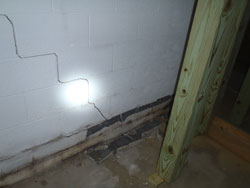 The basement wall primarily supports the vertical load of the building’s weight, but it also retains the lateral pressure of the backfill soil’s weight. This force is very substantial but often overlooked in the construction process. Over time, cracks can form in the subsurface basement wall as a result of the lateral soil pressure forces. Typically the wall begins to bow or bulge inward progressively until it shifts inward at the bottom or until complete and catastrophic failure. A quick and accurate assessment of this type of problem is critical since repairs can be made relatively inexpensively if the problem is caught before the inevitable complete collapse occurs.
The basement wall primarily supports the vertical load of the building’s weight, but it also retains the lateral pressure of the backfill soil’s weight. This force is very substantial but often overlooked in the construction process. Over time, cracks can form in the subsurface basement wall as a result of the lateral soil pressure forces. Typically the wall begins to bow or bulge inward progressively until it shifts inward at the bottom or until complete and catastrophic failure. A quick and accurate assessment of this type of problem is critical since repairs can be made relatively inexpensively if the problem is caught before the inevitable complete collapse occurs.
Truss failure
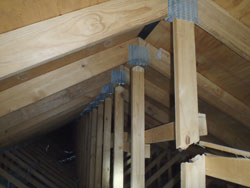 Trusses are engineered to make it possible to span longer distances than solid members, and they are typically more efficient using less materials and labor. Building material suppliers have developed specialized computer software for designers to quickly and accurately design and specify member sizes and connector plates required to safely carry the design loads for the building.
Trusses are engineered to make it possible to span longer distances than solid members, and they are typically more efficient using less materials and labor. Building material suppliers have developed specialized computer software for designers to quickly and accurately design and specify member sizes and connector plates required to safely carry the design loads for the building.
There are a number of conditions that can result in failure of a metal plate-connected wood truss, or other engineered trusses including improper design and sizing of the truss members, manufacturing errors, mishandling during construction, improper loading, improper cutting or notching, inadequate bracing during construction, inadequate permanent bracing, and environmental conditions. Understanding the principles of wood truss design is essential to accurately diagnose the cause of damage and formulate recommendations for repair. We often reverse-engineer failing trusses to determine the loads applied to each individual member and we are then able to determine the cause of the damages.
Structural failure or sagging problems
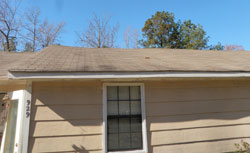 Wood frame construction is and has been the primary method of residential construction throughout North America. Not only is understanding the fundamentals of wood construction essential to building a stable structure, it is equally important in diagnosing problems. For example, wood framing members are subject to long-term “creep” which results in gradual and permanent sagging of members that are loaded to relatively high levels. Because of this property, collapse of wood-framed buildings can occur years after construction has finished, In addition, insect or fungal infestation can lead to long-term sagging problems or failure. Moreover, many wood-framed buildings are not engineered, so improper load paths are sometimes created, and inappropriate cutting/notching of critical members often occurs during construction. Hence, long-term sagging problems can occur. We have evaluated thousands of wood-framed buildings and we know where to look and how to evaluate the damage. We are not afraid to access attic or crawl spaces if needed to find the cause of the problem and to determine whether it is of a long-term or sudden nature.
Wood frame construction is and has been the primary method of residential construction throughout North America. Not only is understanding the fundamentals of wood construction essential to building a stable structure, it is equally important in diagnosing problems. For example, wood framing members are subject to long-term “creep” which results in gradual and permanent sagging of members that are loaded to relatively high levels. Because of this property, collapse of wood-framed buildings can occur years after construction has finished, In addition, insect or fungal infestation can lead to long-term sagging problems or failure. Moreover, many wood-framed buildings are not engineered, so improper load paths are sometimes created, and inappropriate cutting/notching of critical members often occurs during construction. Hence, long-term sagging problems can occur. We have evaluated thousands of wood-framed buildings and we know where to look and how to evaluate the damage. We are not afraid to access attic or crawl spaces if needed to find the cause of the problem and to determine whether it is of a long-term or sudden nature.Retaining wall damage
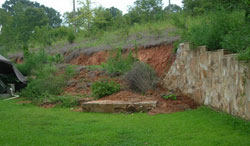 Retaining walls can be significant structures because they must resist large lateral forces from the backfill soil weight and they typically are not supported at the top. Therefore, they either must be very heavy, have very wide footings or they must be structurally connected to solid ground through “tie-back” anchors. Unfortunately, we have found a large number of retaining walls that lean excessively or fail because of faulty design or construction, or because of poor drainage conditions. Retaining walls can also be damaged from impacts, subsidence, earthquakes, floods, or product defects. Many masonry retaining walls are cantilevered structures without a top support, and so they must be constructed with a very wide underground footing and with steel reinforcement to rigidly connect the footing to the stem. Often these walls fail because of inadequate footings or inadequate steel reinforcement. We see a lot of timber or railroad tie retaining walls that fail from long-term decay or from inadequate design. Wood retaining walls generally are incapable of structural stability when built to heights of more than about 4 to 5 feet. Segmental masonry retaining walls are made of special dry-stacked blocks that form a weighty wall, but they must be anchored to the ground with synthetic soil-reinforcing grids. Because of our extensive experience in evaluating retaining wall failures, we can ascertain the type of wall and we know the critical elements of each type allowing us to quickly pinpoint the cause of the failure.
Retaining walls can be significant structures because they must resist large lateral forces from the backfill soil weight and they typically are not supported at the top. Therefore, they either must be very heavy, have very wide footings or they must be structurally connected to solid ground through “tie-back” anchors. Unfortunately, we have found a large number of retaining walls that lean excessively or fail because of faulty design or construction, or because of poor drainage conditions. Retaining walls can also be damaged from impacts, subsidence, earthquakes, floods, or product defects. Many masonry retaining walls are cantilevered structures without a top support, and so they must be constructed with a very wide underground footing and with steel reinforcement to rigidly connect the footing to the stem. Often these walls fail because of inadequate footings or inadequate steel reinforcement. We see a lot of timber or railroad tie retaining walls that fail from long-term decay or from inadequate design. Wood retaining walls generally are incapable of structural stability when built to heights of more than about 4 to 5 feet. Segmental masonry retaining walls are made of special dry-stacked blocks that form a weighty wall, but they must be anchored to the ground with synthetic soil-reinforcing grids. Because of our extensive experience in evaluating retaining wall failures, we can ascertain the type of wall and we know the critical elements of each type allowing us to quickly pinpoint the cause of the failure.

Fire damage evaluation
 We are often asked to determine the extent of damage from fire losses. We can evaluate each structural member and determine whether the damage is superficial or structural in nature, and we can evaluate the remaining strength. We can also inspect chimney flues with specially designed video cameras to determine whether the chimney liner has been damaged by a chimney fire.
We are often asked to determine the extent of damage from fire losses. We can evaluate each structural member and determine whether the damage is superficial or structural in nature, and we can evaluate the remaining strength. We can also inspect chimney flues with specially designed video cameras to determine whether the chimney liner has been damaged by a chimney fire.

Mold/Mildew causation evaluation
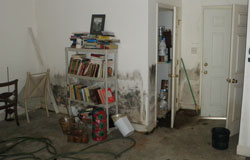 The conditions necessary for mold growth are wide-ranging, but the conditions may be found in almost any living environment. In particular, mold growth requires a surface grow on, a food source, moderate air, temperatures, and moisture. Liquid moisture is not necessary to promote mold/mildew growth, only high humidity levels in the air. When all of these conditions are met, mold growth can appear within about 48 to 72 hours. If any of the necessary conditions are removed, mold will not be active or will go dormant. Since air, moderate temperatures and food sources are always abundant in occupied buildings, the only way to prevent mold/mildew growth is to limit the moisture or humidity levels.
The conditions necessary for mold growth are wide-ranging, but the conditions may be found in almost any living environment. In particular, mold growth requires a surface grow on, a food source, moderate air, temperatures, and moisture. Liquid moisture is not necessary to promote mold/mildew growth, only high humidity levels in the air. When all of these conditions are met, mold growth can appear within about 48 to 72 hours. If any of the necessary conditions are removed, mold will not be active or will go dormant. Since air, moderate temperatures and food sources are always abundant in occupied buildings, the only way to prevent mold/mildew growth is to limit the moisture or humidity levels.
We have extensive experience in determining the source of moisture intrusion problems, leading to mold/mildew growth and/or rot/decay. We can ascertain whether the moisture intrusion is related to ground surface run-off water, wind-driven rain, condensation, plumbing leaks, roof leaks, or construction defects. We have evaluated thousands of homes for leakage through synthetic siding, stucco, or brick veneer and have unsurpassed knowledge of the weaknesses in these exteriors, particularly if critical details of construction are not followed. In many cases, we find that mysterious mold/mildew growths are actually unrelated to leaks, but occur due to condensation problems within the building envelope due to misplaced vapor barriers or inadequate ventilation. We often have to analyze the heating/cooling or ventilation systems and ducting to isolate the cause of condensation problems.
Building envelope analysis
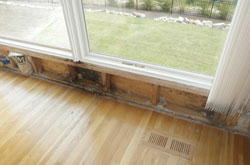 The building envelope is like the skin of your building – it prevents air, moisture and heat from flowing in or out and protects what’s inside. It consists of exterior walls, windows, doors, basement walls, ceilings and the roof. There are many components comprising the building envelope, several of which are hidden from view, and small failures of single or multiple components can lead to major problems affecting the property and living spaces. By analyzing the robustness of the envelope and checking it for “red flags” based on our previous experience, our engineers can identify problems quickly – and possibly even prevent future ones.
The building envelope is like the skin of your building – it prevents air, moisture and heat from flowing in or out and protects what’s inside. It consists of exterior walls, windows, doors, basement walls, ceilings and the roof. There are many components comprising the building envelope, several of which are hidden from view, and small failures of single or multiple components can lead to major problems affecting the property and living spaces. By analyzing the robustness of the envelope and checking it for “red flags” based on our previous experience, our engineers can identify problems quickly – and possibly even prevent future ones.

Litigation consulting and support
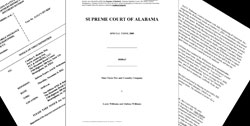 Our forensic engineers are uniquely qualified to evaluate mechanical and structural damage stemming from a variety of causes including wind events, flooding, ice and snow loading, fires, mechanical impact from vehicles and debris, ground subsidence or nearby construction. We have investigated collapses and failures of building components and mechanical systems, differential foundation movement, the effects of long-term deterioration on structural components, and design and construction defects. Our detailed reports and thorough inspections lend themselves to resolution of disputes, preventing costly and lengthy litigation. However, in the unfortunate event of litigation, you can be confident with our analysis and we will be available to defend our conclusions. We have been asked to testify as an expert witness in hundreds of cases, for both plaintiffs and defendants.
Our forensic engineers are uniquely qualified to evaluate mechanical and structural damage stemming from a variety of causes including wind events, flooding, ice and snow loading, fires, mechanical impact from vehicles and debris, ground subsidence or nearby construction. We have investigated collapses and failures of building components and mechanical systems, differential foundation movement, the effects of long-term deterioration on structural components, and design and construction defects. Our detailed reports and thorough inspections lend themselves to resolution of disputes, preventing costly and lengthy litigation. However, in the unfortunate event of litigation, you can be confident with our analysis and we will be available to defend our conclusions. We have been asked to testify as an expert witness in hundreds of cases, for both plaintiffs and defendants.
Swimming pools
Flooring problems
Mechanical component failures
Plumbing leaks/failures
Foundation settlement
Construction defects
Moisture intrusion & leak evaluation
Roofing evaluation


